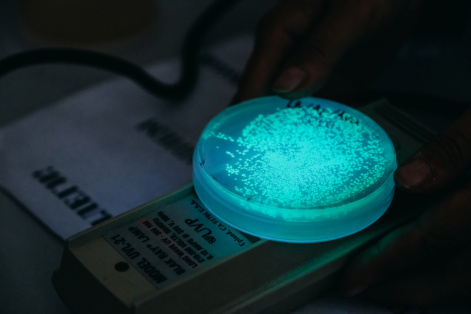Krasnoyarsk scientists have determined the parameters of the protein responsible for the glow of the ctenophore
13 October 2022 г.

The name of this type of marine organisms speaks for itself. The gelatinous bodies of ctenophores (Ctenophora) are fitted with eight rows of rowing plates with cilia, allowing them to float both at the water surface and at the bottom. For coelenterates, this mechanism is quite primitive, but the anatomy of the ctenophores is sometimes more complicated than the structure of their jellyfish relatives (the ctenophores are more ancient organisms on the evolutionary ladder).
Bioluminescence is inherent in almost all types of ctenophores. Calcium-regulated photoproteins are responsible for the glow of such plankton organisms, like jellyfish and some squids. This is a protein complex of apoprotein with a bioluminescent reaction substrate. It is located in special cells - photocytes, and they are combined into photophore organs. The latter are located in ctenophores along the rowing plates and around the mouth opening.
Senior Researcher of the Laboratory of Photobiology at Institute of Biophysics SB RAS Lyudmila Burakova explains:
“Calcium ions are also responsible for the conduction of nerve impulses, so the luminescence is usually associated with irritation. If you disturb a ctenophore or a jellyfish, their nerve impulses will react, releasing calcium ions in the cells. When they combine with photoproteins (calcium-binding proteins) in photocytes and luminescence begins. So this type of bioluminescence is a response to an external stimulus.”
Animals most often use glow to attract prey or, conversely, to scare away predators, like some crustaceans, or for communication, like fireflies. As for ctenophores and jellyfish, they probably use the glow to lure plankton. Observers usually describe ctenophores as beautiful and gentle creatures. But don't be fooled by the mesmerizing brilliance and bluish-greenish glow, they hide some of the most voracious intestinal predators. For a long time, ctenophores were considered a trophic dead end in marine food chains, but, as it turned out, in addition to zooplankton and larvae, sea anemones, jellyfish, and even small fish and crustaceans fall into their trap. Therefore, their role in marine food chains is more complex than previously thought.
When one of the species of ctenophores was brought to the Caspian, Azov and Black Seas, it began to actively devour zooplankton and fish eggs, which caused significant damage to local fisheries and almost led to a local ecological crisis. These creatures are incredibly resistant even to very salty environments, due to which they were able to spread in almost all seas and oceans (at the moment, about 150 species are known, many of which have not been studied). Researchers of the Institute of Biophysics SB RAS studied bioluminescent proteins based on the genetic material of ctenophores caught from the White Sea. Now the proteins encoded by the genes found are being produced by Escherichia coli.
Despite the fact that ctenophores are found almost everywhere and many of them are luminous, recombinant photoproteins have been obtained for only four of them. “Calcium-regulated photoproteins are a unique type of bioluminescent proteins responsible for the light emission of cnidarians and ctenophores,” says Lyudmila Burakova. - At present, the genes of photoproteins of four genera of ctenophores and the same number of hydrojellyfish have been cloned. Such parameters as specific activity, quantum yield and absorption coefficient of the photoprotein complex for recombinant berovin have been estimated for the first time. Before that, scientists tried to make such measurements only on natural proteins isolated directly from the organisms.”
Ctenophores began to be studied not so long ago and there are still not so many data on this type of organisms. The degree of identity of the amino acid sequences of photoproteins of ctenophore (Ctenophora) and cnidarians (Cnidaria) turned out to be very low - about thirty percent, which made it possible to attribute photoproteins of ctenophores to a new type of Ca2+ - regulated photoproteins. The most significant difference was the sensitivity of ctenophores to light irradiation.
How are the luminescent abilities of these creatures used in molecular biology and medicine? Any recorded signal can become a marker for measuring the concentrations of various substances. Luminous proteins are attached to antibodies and used as a marker part of a molecule for bioluminescent biospecific analysis in order to determine the percentage of certain components outside the body, for example, in blood serum or urine. Special devices measure the number of light quanta emitted by proteins. These molecules can also be used to monitor the distribution of calcium fluxes in a cell.
“Bioluminescent proteins are promising because they are harmless to the body and are applicable both in vitro and in vivo,” explains Lyudmila Burakova. “In addition, they are also used in cell lines for drug testing. The genes of these proteins are introduced into cells, then they take a whole pool of biologically active compounds that can potentially be drugs. If one observes luminescence when the protein is added to the cell, it means the medicine is working.”
Source: "Science in Siberia"
Share:
